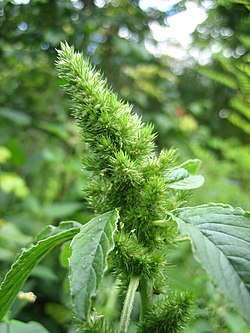Amaranthus retroflexus
This article possibly contains original research. (August 2021) |
| Amaranthus retroflexus | |
|---|---|

| |
| Scientific classification | |
| Kingdom: | Plantae |
| Clade: | Tracheophytes |
| Clade: | Angiosperms |
| Clade: | Eudicots |
| Order: | Caryophyllales |
| Family: | Amaranthaceae |
| Genus: | Amaranthus |
| Species: | A. retroflexus
|
| Binomial name | |
| Amaranthus retroflexus | |
| Synonyms[2][3] | |
| |
Amaranthus retroflexus is a species of flowering plant in the family Amaranthaceae with several common names, including red-root amaranth, redroot pigweed, red-rooted pigweed, common amaranth, pigweed amaranth, and common tumbleweed.[4]
Outside of its native range, it is considered a weed. Although it may be toxic if eaten uncooked, or in excess by livestock, it can be consumed as a vegetable or as fodder.
Description
[edit]Amaranthus retroflexus, true to one of its common names, forms a tumbleweed.[4] It is an erect, annual herb growing to 1 m (3+1⁄2 ft).[5] The leaves are nearly 15 cm (6 in) long on large individuals, the ones higher on the stem having a lance shape and those lower on the plant diamond or oval in shape. The plant is monoecious, with individuals bearing both male and female flowers. The inflorescence is a large, dense cluster of flowers interspersed with spiny green bracts. The fruit is a capsule less than 2 mm (1⁄16 in) long[6] with a "lid" which opens to reveal a tiny black seed.
Distribution and habitat
[edit]It may be native to the Neotropics[7] or Central and Eastern North America,[8] but is widespread as an introduced species on most continents in a great number of habitats.
One common name is "pigweed" because it grows where hogs are pasture-fed.
As a weed
[edit]A. retroflexus is a weed outside its native range and has developed resistance against fomesafen in Northeast China.[9]
Potential toxicity
[edit]No species of genus Amaranthus is known to be poisonous to humans,[10] but the leaves of A. retroflexus contain oxalic acid and may contain nitrates if grown in nitrate-rich soils.[11]
Like many other species of Amaranthus, this plant may be harmful and even deadly when fed to cattle and pigs in large amounts over several days. Such forage may cause fatal nephrotoxicity,[12] presumably because of its high oxalate content. Other symptoms, such as bloat or methylglobineamia in the most severe cases, might reflect its high nitrate content.[13]
Uses
[edit]Culinary
[edit]This plant is eaten as a vegetable in different places of the world. The water should be discarded after boiling due to the presence of oxalic acid and possibly nitrates. The young shoots and leaves can be eaten raw.[11] The leaves are high in calcium, iron, protein, and phosphorus.[11]
A. retroflexus was used for a multitude of food and medicinal purposes by many Native American groups in the western United States.[14] It is among the species consumed as a vegetable in Mexican markets as Quelite quintonil.
It is used in the Indian state of Kerala to prepare a popular dish known as thoran by combining the finely cut leaves (cheera ) with grated coconut, chili peppers, garlic, turmeric and other ingredients.
The seeds are edible raw[6] or toasted, and can be ground into flour and used for bread, hot cereal, or as a thickener.[15]
-
Southern Kerala-style traditional thoran made with A. retroflexus
As fodder
[edit]When supplied in moderation (circumventing its toxicity to livestock), it is regarded as an exceptionally nutritious fodder.[16]
References
[edit]- ^ NatureServe (5 May 2023). "Amaranthus retroflexus". NatureServe Network Biodiversity Location Data accessed through NatureServe Explorer. Arlington, Virginia: NatureServe. Retrieved 17 May 2023.
- ^ "Amaranthus retroflexus". Tropicos. Missouri Botanical Garden.
- ^ The Plant List
- ^ a b Pammel, Louis Hermann (1903). Some Weeds of Iowa. Experiment Station, Iowa State College of Agriculture and the Mechanic Arts. p. 470.
- ^ Francis-Baker, Tiffany (2021). Concise Foraging Guide. The Wildlife Trusts. London: Bloomsbury. p. 56. ISBN 978-1-4729-8474-6.
- ^ a b Elias, Thomas S.; Dykeman, Peter A. (2009) [1982]. Edible Wild Plants: A North American Field Guide to Over 200 Natural Foods. New York: Sterling. p. 72. ISBN 978-1-4027-6715-9. OCLC 244766414.
- ^ "Amaranthus retroflexus". Fire Effects Information System (FEIS).
- ^ "Amaranthus retroflexus (red-rooted amaranth)". Go Botany.
- ^ Huang, Zhaofeng; Cui, Hailan; Wang, Chunyu; Wu, Tong; Zhang, Chaoxian; Huang, Hongjuan; Wei, Shouhui (2020). "Investigation of resistance mechanism to fomesafen in Amaranthus retroflexus L.". Pesticide Biochemistry and Physiology. 165. Elsevier: 104560. Bibcode:2020PBioP.16504560H. doi:10.1016/j.pestbp.2020.104560. ISSN 0048-3575. PMID 32359536. S2CID 216246076.
- ^ Plants for a future Archived January 15, 2009, at the Wayback Machine
- ^ a b c Benoliel, Doug (2011). Northwest Foraging: The Classic Guide to Edible Plants of the Pacific Northwest (Rev. and updated ed.). Seattle, WA: Skipstone. p. 95. ISBN 978-1-59485-366-1. OCLC 668195076.
- ^ FEIS Ecology
- ^ van Wyk, Ben-Erik; van Heerden, Fanie; van Oudtshoorn, Bosch (2002). Poisonous Plants of South Africa. Pretoria: Briza. ISBN 978-1-875093-30-4.
- ^ "Native American Ethnobotany Data Base, search of Amaranthus retroflexus". Retrieved March 6, 2022.
- ^ "Amaranthus retroflexus | Redroot Pigweed | Male Finger". Archived from the original on 2014-03-04. Retrieved 2014-02-28.
- ^ Watt, John Mitchell; Breyer-Brandwijk, Maria Gerdina: The Medicinal and Poisonous Plants of Southern and Eastern Africa 2nd ed Pub. E & S Livingstone 1962
External links
[edit] Media related to Amaranthus retroflexus (category) at Wikimedia Commons
Media related to Amaranthus retroflexus (category) at Wikimedia Commons- Jepson Manual Treatment
- Amaranthus reflexus in the CalPhotos photo database, University of California, Berkeley
- Amaranthus retroflexus L. Medicinal Plant Images Database (School of Chinese Medicine, Hong Kong Baptist University) (in Chinese) (in English)
- "Amaranthus retroflexus". Plants for a Future.



